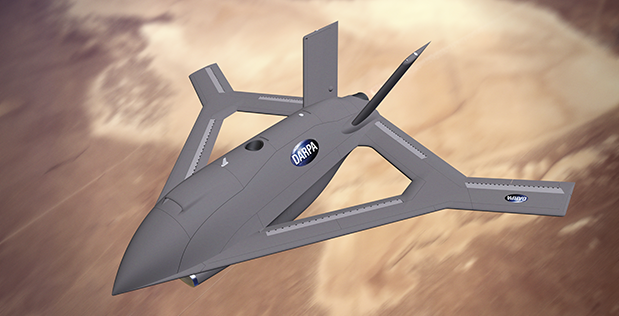
 The brothers Wright solved the conundrum of three-axis control for powered aircraft with the pitch, yaw, and roll control through the combined forces of an elevator, rudder, and wing warping. Glenn Curtiss effectively won his roll control legal battle with the brothers when he replaced a warping roll with a French “little wing, “ aka the aileron. (And then came roll-control spoilers, like those on the P-61 Black Widow.) One wonders what the Wrights (and Curtiss as well) would think of a powered flying machine that achieved three-axis control without any of these moving control surfaces? For DARPA, the Defense Advanced Research Projects Agency, Aurora Flight Sciences, a subsidiary of Boeing, is building the X-65 to realize the possibilities of Active Flow Control, part of DARPA’s CRANE, Control of Revolutionary Aircraft with Novel Effectors.
The brothers Wright solved the conundrum of three-axis control for powered aircraft with the pitch, yaw, and roll control through the combined forces of an elevator, rudder, and wing warping. Glenn Curtiss effectively won his roll control legal battle with the brothers when he replaced a warping roll with a French “little wing, “ aka the aileron. (And then came roll-control spoilers, like those on the P-61 Black Widow.) One wonders what the Wrights (and Curtiss as well) would think of a powered flying machine that achieved three-axis control without any of these moving control surfaces? For DARPA, the Defense Advanced Research Projects Agency, Aurora Flight Sciences, a subsidiary of Boeing, is building the X-65 to realize the possibilities of Active Flow Control, part of DARPA’s CRANE, Control of Revolutionary Aircraft with Novel Effectors.
The X-65’s geometric joined-wing structure certainly is revolutionary, and I would have loved to have listened to the meeting that renamed aerodynamic flight controls, the rudder, elevators, and ailerons “effectors.” At least it makes sense. Without moving flight controls, active flows of air will effect changes in the unmanned X plane’s pitch, roll, and yaw. But wait! There’s more! The 7,000-pound research aircraft includes modular wing configurations so it can integrate and test other advanced CRANE technology. As DARPA put it: “Crane seeks to optimize the benefits of active flow control by maturing technologies and design tools, and incorporating them early in the design process. Active flow control could improve aircraft performance by removing jointed surfaces, which currently drive design configurations that increase weight and mechanical complexity. Demonstrating AFC for stability and control in-flight would help open the design trade space for future military and commercial applications.”
 Time will tell whether the X-65 begins its flight testing, scheduled for 2025, but the project has completed four weeks of wind tunnel testing in Phase 1. Surely those tunnel tests included controlling the aircraft’s attitude with inhaling and exhaling air from the myriad vents on the wings that give Active Flow Control its name. With only a rudimentary comprehension of fluid dynamics, it seems that ACF will create a pitch, roll, and yaw effector by changing the shape of the boundary layers flowing over the geometrically joined wings. (Here is BAE’s YouTube take on the subject.) What I’m curious to learn is how effective this new active flow effector is compared to mechanical airflow deflectors, the traditional rudder, elevators, and ailerons (and spoilers, too!). The roll control legal patent battles between the Wrights and Curtiss aside, the aileron won because it was more immediately effective and it was easier to design and build, and it weighed less. In these regards, aviation’s practical demands remain unchanged. Scott Spangler, Editor
Time will tell whether the X-65 begins its flight testing, scheduled for 2025, but the project has completed four weeks of wind tunnel testing in Phase 1. Surely those tunnel tests included controlling the aircraft’s attitude with inhaling and exhaling air from the myriad vents on the wings that give Active Flow Control its name. With only a rudimentary comprehension of fluid dynamics, it seems that ACF will create a pitch, roll, and yaw effector by changing the shape of the boundary layers flowing over the geometrically joined wings. (Here is BAE’s YouTube take on the subject.) What I’m curious to learn is how effective this new active flow effector is compared to mechanical airflow deflectors, the traditional rudder, elevators, and ailerons (and spoilers, too!). The roll control legal patent battles between the Wrights and Curtiss aside, the aileron won because it was more immediately effective and it was easier to design and build, and it weighed less. In these regards, aviation’s practical demands remain unchanged. Scott Spangler, Editor
Related Posts:
on Monday, October 2nd, 2023 at 8:00 am and is filed under Aerospace, Drones, Military, The Buzz.
You can follow any responses to this entry through the RSS 2.0 feed.
Both comments and pings are currently closed.
Discover more from reviewer4you.com
Subscribe to get the latest posts to your email.





